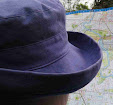Members of the Cheer up Brigade beside the Darge Studio building. The brigade was a patriotic group of women who visited AIF camps at Broadmeadows, Maribyrnong, Domain and Ascot Vale. They served afternoon tea to soldiers on Sundays, and had an autograph book of soldiers signatures. c September 1917. Darge Photographic Company. AWM DAX1828
The notion of a Cheer-up Society began in South Australia in 1915 where it did a variety of work in fund-raising, providing lunches for returning soldiers and manning a booth near the train station in Adelaide. In Melbourne the idea of a Cheer-up Brigade was conceived as a children's movement, where groups of children undertook to entertain soldiers. This quickly became unwieldy and adults had to step in when the demand for teas went beyond what children and parents could supply in an ad hoc setting. Soon women were organising to provide regular high teas for soldiers in camps near them. Formal organisations started up around the camps at Royal Park and Broadmeadows, and soon the Maribyrnong camp also required some attention. The celebration of second year anniversaries in September 1917 shows that this form of patriotic work began operation in September 1915. It was not until September 1917 that a group was formed to provide services to the Showgrounds and Ascot Vale Isolation Camps. The formation of the Ascot Vale Branch was organised by the already active Royal Park and Maribyrnong Cheer-up Brigades, and it seems likely that those two groups had already been involved in providing teas for the soldiers in Ascot Vale. At this time Mrs W T Osborne stepped up to take on the leadership of the new branch.
Mary Isabel Osborne was the wife of William Thomas Osborne, a State School teacher. In 1905 Osborne had been teaching at Yea, but by 1909 the family had moved to the house in Francis St, Ascot Vale which became their home for the duration of the war. The Osborne's second son, H T (Pat) Osborne, enlisted in 1915. 'Mrs W T Osborne' was mentioned from time to time in the papers doing Red Cross work, but it may have been no co-incidence that she took on a heavier workload working with soldiers after the family learnt that Pat had received a shocking injury and had his leg amputated. He had been a keen sportsman before the war, and was a notable golf and tennis player, but Pat took a firmly cheerful view of the matter, and he returned to golf on his prosthetic leg.
"Every Saturday, at 5 p.m., every man in camp, whether sick or on duty, receives the following tea: -For the hospital wards -jelly, 2 slices cream sandwich, 1 rainbow,1 Swiss roll, 1 diamond sponge (special diet). Men in camp-Each 1 hot meat pie. 1 slice Vic. sandwich, 2 pasties, 2 buttered scones, 1 cake, tea, milk and sugar. The average strength of the camp is 150 men. Cost of tea, 6d per man.
Every house surrounding the camp has adopted a soldier for Saturday tea, and is guaranteeing it every week till the war ends. No less than the following permanent donations (150 in number, and sundries, bringing it up to 180 in three weeks) have been received, and anyone wishing to do likewise may leave donations either at the Isolation Camp, in charge of guard at gate, or Mrs. McCreary, Puckle st.; Mrs. Guest, baker, Railway Crescent, Ascot Vale; or Mrs. W. T. Osborne. "Corneville." 19 Francis street. Ascot Vale.For further information about the work of the Cheer-up Brigade, and the women who worked with Mrs Osborne, go to The Empire Called website.
PATRIOTIC (1917, May 10). The Essendon Gazette and Keilor, Bulla and Broadmeadows Reporter (Moonee Ponds, Vic. : 1914 - 1918), p. 3 (Morning). http://nla.gov.au/nla.news-article74602492













No comments:
Post a Comment